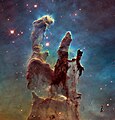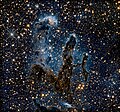Fájl:Eagle Nebula - GPN-2000-000987.jpg

Az előnézet mérete: 606 × 600 képpont További felbontások: 242 × 240 képpont | 485 × 480 képpont | 776 × 768 képpont | 1 035 × 1 024 képpont | 1 944 × 1 924 képpont.
Eredeti fájl (1 944 × 1 924 képpont, fájlméret: 1,18 MB, MIME-típus: image/jpeg)
Fájltörténet
Kattints egy időpontra, hogy a fájl akkori állapotát láthasd.
| Dátum/idő | Bélyegkép | Felbontás | Feltöltő | Megjegyzés | |
|---|---|---|---|---|---|
| aktuális | 2012. október 3., 02:30 |  | 1 944 × 1 924 (1,18 MB) | Ras67 | losslessly cropped with Jpegcrop |
| 2009. április 9., 03:17 |  | 1 993 × 1 973 (1,45 MB) | BotMultichillT | {{Information |Description={{en|1=These eerie, dark pillar-like structures are columns of cool interstellar hydrogen gas and dust that are also incubators for new stars. The pillars protrude from the interior wall of a dark molecular cloud like stalagmite |
Fájlhasználat
Az alábbi lap használja ezt a fájlt:
Globális fájlhasználat
A következő wikik használják ezt a fájlt:
- Használata itt: ar.wikipedia.org
- Használata itt: en.wikipedia.org
- Használata itt: eu.wikipedia.org
- Használata itt: fa.wikipedia.org
- Használata itt: ka.wikipedia.org
- Használata itt: kw.wikipedia.org
- Használata itt: zh.wikipedia.org






